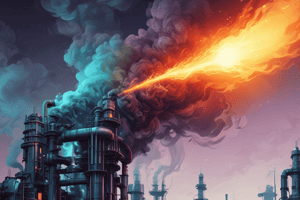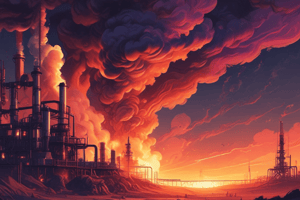Podcast
Questions and Answers
What is the primary product of methane combustion in the presence of oxygen?
What is the primary product of methane combustion in the presence of oxygen?
- Methane
- Nitrogen Dioxide
- Carbon Dioxide (correct)
- Ozone
Which process describes the conversion of glucose and oxygen into energy?
Which process describes the conversion of glucose and oxygen into energy?
- Respiration (correct)
- Oxidation
- Fermentation
- Photosynthesis
In which part of the cell does the Krebs Cycle occur?
In which part of the cell does the Krebs Cycle occur?
- Nucleus
- Mitochondria (correct)
- Cytoplasm
- Chloroplast
What is an example of an exothermic reaction involving oxygen?
What is an example of an exothermic reaction involving oxygen?
What is the role of oxygen in oxidation reactions?
What is the role of oxygen in oxidation reactions?
During respiration, what is produced alongside energy?
During respiration, what is produced alongside energy?
What do combustion reactions generally require to occur?
What do combustion reactions generally require to occur?
Which stage of respiration involves the breakdown of glucose into pyruvate?
Which stage of respiration involves the breakdown of glucose into pyruvate?
What is the overall combustion reaction for glucose?
What is the overall combustion reaction for glucose?
Which reaction type typically produces heat and light?
Which reaction type typically produces heat and light?
What is formed when iron reacts with oxygen and water?
What is formed when iron reacts with oxygen and water?
Which chemical equation represents the oxidation of glucose during cellular respiration?
Which chemical equation represents the oxidation of glucose during cellular respiration?
What role does oxygen play in the basic oxygen process in steel production?
What role does oxygen play in the basic oxygen process in steel production?
What is produced when oxygen forms from the electrical discharge method?
What is produced when oxygen forms from the electrical discharge method?
What is one significant environmental process that utilizes oxygen?
What is one significant environmental process that utilizes oxygen?
How does oxygen contribute to water treatment processes?
How does oxygen contribute to water treatment processes?
What is a safety concern associated with high concentrations of oxygen?
What is a safety concern associated with high concentrations of oxygen?
Which of the following is NOT a use of oxygen in industrial processes?
Which of the following is NOT a use of oxygen in industrial processes?
Why is oxygen considered a powerful oxidizing agent?
Why is oxygen considered a powerful oxidizing agent?
What product results from the decomposition of organic matter by microorganisms in the presence of oxygen?
What product results from the decomposition of organic matter by microorganisms in the presence of oxygen?
Flashcards are hidden until you start studying
Study Notes
Oxygen in Reactions
- Oxygen is a highly reactive element that plays a crucial role in various chemical reactions, such as combustion, respiration, and oxidation.
- Oxygen's involvement in these reactions is essential for both life and industry.
Combustion Reactions
- Combustion is an exothermic reaction where a substance reacts with oxygen to produce heat and light.
- This reaction is fundamental to energy production and many industrial processes.
- Fuel + O2 → CO2 + H2O + Heat
- Examples:
- Burning of Hydrocarbons: Hydrocarbons, like methane (CH4), burn in the presence of oxygen to produce carbon dioxide and water. This powers natural gas stoves and heaters.
- CH4 + 2O2 → CO2 + 2H2O + Heat
- Combustion of Wood: This involves complex reactions, primarily producing carbon dioxide, water, and heat.
- C6H12O6 + 6O2 → 6CO2 + 6H2O + Heat
Respiration
- Respiration is a biochemical process where cells convert glucose and oxygen into energy (ATP), carbon dioxide, and water.
- It's essential for energy production in living organisms.
- C6H12O6 + 6O2 → 6CO2 + 6H2O + Energy
- Respiration occurs in three stages:
- Glycolysis: Glucose breaks down into pyruvate, producing a small amount of ATP and NADH.
- Krebs Cycle: Acetyl-CoA is oxidized, generating CO2, NADH, and FADH2.
- Electron Transport Chain: Transfers electrons from NADH and FADH2, producing ATP and water as oxygen combines with electrons and protons.
Oxidation Reactions
- Oxidation reactions involve the transfer of electrons between substances.
- Oxygen often acts as an oxidizing agent, accepting electrons from another substance.
- These reactions are essential in numerous industrial processes and environmental systems.
- Substance + O2 → Oxidized Product
- Examples:
- Rusting of Iron: Iron reacts with oxygen in the presence of water, forming iron oxide (rust).
- 4Fe + 3O2 + 6H2O → 4Fe(OH)3 → 2Fe2O3 · 3H2O
- Respiratory Oxidation: In cellular respiration, glucose is oxidized, and oxygen is reduced, ultimately forming water and releasing energy.
- Rusting of Iron: Iron reacts with oxygen in the presence of water, forming iron oxide (rust).
Oxygen in Industrial Processes
- Oxygen is used in various industrial processes to enhance reaction rates and produce desired products.
- Examples:
- Steel Production: Oxygen is blown into molten iron to remove impurities and produce steel. It reacts with carbon and other elements, forming gases like CO2 and CO.
- Fe + O2 → FeO
- Ozone Production: Oxygen is used to produce ozone (O3) through the electrical discharge method. Ozone is used in water treatment and as an industrial oxidizing agent.
- 3O2 → 2O3
- Steel Production: Oxygen is blown into molten iron to remove impurities and produce steel. It reacts with carbon and other elements, forming gases like CO2 and CO.
Oxygen in Environmental Processes
- Oxygen plays a vital role in environmental processes, impacting ecosystems and pollution levels.
- Examples:
- Decomposition: Oxygen is essential for the decomposition of organic matter by microorganisms. This process converts dead plant and animal material into simpler compounds and releases nutrients back into the soil.
- Organic Matter + O2 → CO2 + H2O + Nutrients
- Water Treatment: Oxygen is used in water treatment to facilitate the breakdown of organic pollutants. Aeration introduces oxygen into wastewater, promoting the activity of aerobic bacteria that degrade contaminants.
- Organic Pollutants + O2 → Degradation Products
- Decomposition: Oxygen is essential for the decomposition of organic matter by microorganisms. This process converts dead plant and animal material into simpler compounds and releases nutrients back into the soil.
Safety Considerations
- Handling oxygen and substances involving it requires attention to safety.
- High concentrations of oxygen can cause materials to ignite more easily.
- Reactions involving oxygen should be conducted with proper safety protocols in place.
- Examples:
- Combustion Safety: In industrial settings, ensuring proper ventilation and controlling oxygen levels are critical to prevent accidental fires or explosions.
- Medical Oxygen: In medical settings, oxygen therapy requires careful monitoring to avoid complications such as oxygen toxicity.
Summary
- Oxygen is a versatile element with profound effects on chemical reactions.
- Its involvement in combustion, respiration, oxidation, and industrial processes highlights its importance in both natural and artificial systems.
- Understanding the role of oxygen provides a foundation for understanding chemical processes and their applications in various fields.
Studying That Suits You
Use AI to generate personalized quizzes and flashcards to suit your learning preferences.




